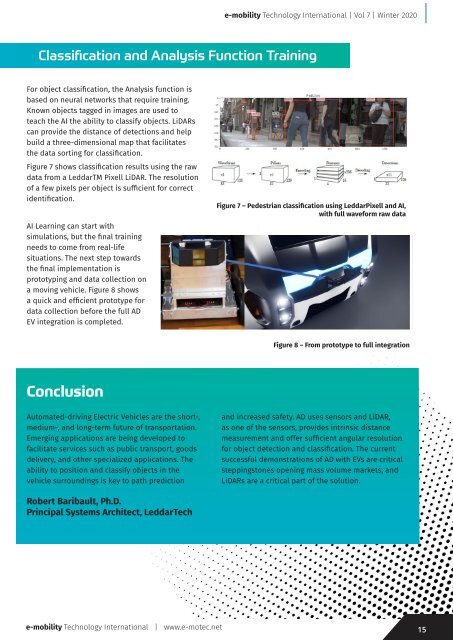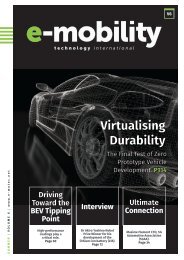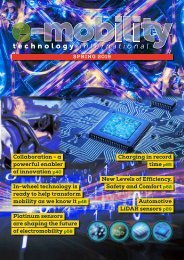E-mobility Technology Winter 2020
Electric vehicle technology news: Maintaining the flow of information for the e-mobility technology sector
Electric vehicle technology news: Maintaining the flow of information for the e-mobility technology sector
You also want an ePaper? Increase the reach of your titles
YUMPU automatically turns print PDFs into web optimized ePapers that Google loves.
e-<strong>mobility</strong> <strong>Technology</strong> International | Vol 7 | <strong>Winter</strong> <strong>2020</strong><br />
Classification and Analysis Function Training<br />
For object classification, the Analysis function is<br />
based on neural networks that require training.<br />
Known objects tagged in images are used to<br />
teach the AI the ability to classify objects. LiDARs<br />
can provide the distance of detections and help<br />
build a three-dimensional map that facilitates<br />
the data sorting for classification.<br />
Figure 7 shows classification results using the raw<br />
data from a LeddarTM Pixell LiDAR. The resolution<br />
of a few pixels per object is sufficient for correct<br />
identification.<br />
AI Learning can start with<br />
simulations, but the final training<br />
needs to come from real-life<br />
situations. The next step towards<br />
the final implementation is<br />
prototyping and data collection on<br />
a moving vehicle. Figure 8 shows<br />
a quick and efficient prototype for<br />
data collection before the full AD<br />
EV integration is completed.<br />
Figure 7 – Pedestrian classification using LeddarPixell and AI,<br />
with full waveform raw data<br />
Figure 8 – From prototype to full integration<br />
Conclusion<br />
Automated-driving Electric Vehicles are the short-,<br />
medium-, and long-term future of transportation.<br />
Emerging applications are being developed to<br />
facilitate services such as public transport, goods<br />
delivery, and other specialized applications. The<br />
ability to position and classify objects in the<br />
vehicle surroundings is key to path prediction<br />
and increased safety. AD uses sensors and LiDAR,<br />
as one of the sensors, provides intrinsic distance<br />
measurement and offer sufficient angular resolution<br />
for object detection and classification. The current<br />
successful demonstrations of AD with EVs are critical<br />
steppingstones opening mass volume markets, and<br />
LiDARs are a critical part of the solution.<br />
Robert Baribault, Ph.D.<br />
Principal Systems Architect, LeddarTech<br />
e-<strong>mobility</strong> <strong>Technology</strong> International | www.e-motec.net<br />
15









